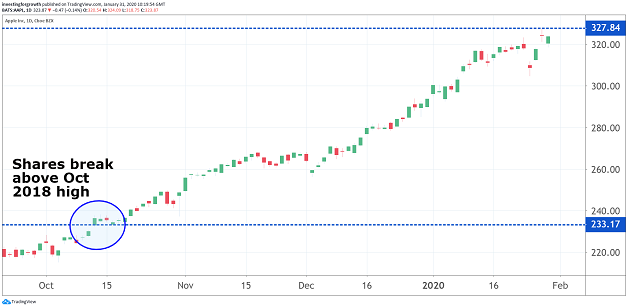Stockwatch: Time to embrace or avoid this ‘must-have’ stock?
Despite new products and loyal customers, our companies analyst wants to discuss growth and valuation.
31st January 2020 10:31
by Edmond Jackson from interactive investor
Despite new products and loyal customers, our companies analyst wants to discuss growth and valuation.

Tuesday’s first-quarter results from Nasdaq-listed Apple (NASDAQ:AAPL) beat the guidance range with an 8.9% jump in revenue to $91.8 billion (£70.1 billion). This batted away some niggling uncertainties such as demand for late-stage 4G iPhones and the US/China trade dispute and, most vitally, affirmed Apple’s business model – of continuing to capitalise on the iPhone’s appeal by way of upgrades, while diversifying into wearables and accessories.
This is in contrast to a few years ago when the iPhone was seen as exposed to competition in a maturing smartphone market. Now, the perception has changed to this helping sales for “the Apple ecosystem” and harnessing 5G networks once they unfold.
Can Apple’s valuation continue to pace its narrative?
The sense of a “must-have” stock emerges both for fund managers who would not be penalised if Apple suddenly put a foot wrong, and for private investors fearing missing out on a big bull market, as fast-moving new products evolve before their eyes.
The stock’s sales pitch is having soared nearly 120% in a year, although, adjusting for market weakness in latter months of 2018, that’s more like 44%. Yet globally and in narrative terms, Apple is indeed stronger than it’s ever been.

Source: TradingView Past performance is not a guide to future performance
Despite repeatedly drawn attention to the diversification prospects, I’m positively stunned how the table shows an 8% leap in iPhone revenues, constituting 61% of the total, with the smaller wearables/accessories segment up 37%, though, as yet, it’s only 11% overall.
So, the trailing price/earnings (PE) ratio has exactly doubled from 12.5x when I turned bullish to Apple’s diversification potential in August 2013 - at a price of $71 adjusted for stock splits - to 25x today with the price around $324.
On a simple arithmetic view, that’s a tough hurdle for a $1.4 trillion company to grow its metrics anywhere near such a rate, and it is reasonable to assume the US Federal Reserve’s supportive monetary policy changes from 24 December 2018 have conflated with Apple’s progress to propel its stock higher. It’s hard to be a party pooper but, in a different monetary environment, and were Apple to encounter setbacks, the stock would be rated lower.
Currently, Apple tops the FAANG stocks with a price/earnings-to-growth (PEG) ratio possibly around 2.3x – implying investors are paying over twice expected underlying earnings – which compares with Netflix (NASDAQ:NFLX) at around 2, Alphabet (NASDAQ:GOOGL) (Google) 1.7 and Amazon (NASDAQ:AMZN) a modest 1.2, helped by very strong growth for its cloud services.
The potential flaw in such a measure is shown by it recently suggesting Facebook as offering best value on a PEG of 1, yet its stock has just plunged 7% after a big jump in quarterly expenses. So, if Apple is now in a sweet spot it could continue beating expectations for a few years and justify a premium.
The stock’s risk/reward profile is thus spicier: it’s potentially more volatile than the US market overall, and there’s no support from a sub-1% yield should the narrative disappoint anytime.
Plenty more life in iPhones
A few years ago, commentators spoke of a slow demise in a saturated global market for smartphones, with plenty cheaper/capable rivals encroaching. Yet, with upgrades – most recently to the iPhone 11 and 11 Pro – and clever price trimming just ahead of Christmas gift buying, sales have shone through.
With an estimated 925 million iPhone users globally, some 350 million of which are thought amenable to upgrades, Apple has scope in the next few years to capitalise on the 5G revolution as it kicks off later this year. Initially, there will be devotees who will upgrade pretty much irrespective of cost, whether to experience the latest speeds or as a status symbol.
A teaser on the 5G iPhone is expected this April ahead of full launch in September. However, at least five new iPhone releases are expected this year, and it will also be interesting to check reception for lower-priced models apparently from March. Helped by financing and trade-in offers, the iPhone looks guaranteed a good few years ahead as its user base steadily switches to 5G.
Apple’s operating system offers a defensive aspect in the sense that existing users will likely want to stay – especially if using other products within the “eco-system” despite price and specifications from Android phones nowadays presenting tough competition. I say this even as someone who does not use Apple products, given strong loyalty among others (I know) who do.
So, in the short to medium term Apple has a margin opportunity ahead, from the initial launch of 5G iPhones, with revenue thereafter from a broader public switch.
Mutually supportive growth gains momentum
A second key take from Apple’s first-quarter results is the way revenue from Wearables, Home and Accessories”, such as AirPods and Apple Watch, is now greater than from the Mac products most traditionally associated with Apple. This new segment surged 37% to over $10 billion of revenue in fourth quarter 2019 versus Mac computers down 3% to $7.2 billion for Mac computers. Apple says it could not make enough of some Wearables etc, to meet demand.
This segment has posted two successive quarters of growth over 50%, constituting around 10% versus the iPhone at 60%. Given the robust prospects for iPhones, I’ve just described, this is encouraging given the “eco-system” is pretty exclusive: Apple Watch won’t sync with Android phones and AirPods ideally work with iPhones. So I envisage this junior segment to continue leveraging sales partly off iPhone growth.
Indeed, the CEO argues that with each Apple product a customer buys, the tighter they get into the ecosystem – experiencing the products thus provides mutually supportive growth. The iPhone still comes first but it is claimed 75% of Watch customers during the latest quarter were buying their first one. And, despite no revenue breakdown provided between Watch and AirPods, the company says Watch sales hit a record during the quarter.
Apple TV is somewhat elusive given the interest was in a 1 November launch of Apple TV Plus in over 100 countries, although management is not clarifying subscribers beyond talk of “a rousing start.”
| Apple Inc - products and services performance | |||||
|---|---|---|---|---|---|
| Three months ended | |||||
| Net sales by category | 28-Dec-18 | 29-Dec-19 % of total change | |||
| $ millions | $ millions | ||||
| iPhone | 51,982 | 55,957 | 61% | 8% | |
| Mac | 7,416 | 7,160 | 8% | -3% | |
| iPad | 6,729 | 5,977 | 6% | -11% | |
| Wearables, Home & Accessories | 7,308 | 10,010 | 11% | 37% | |
| Services | 10,875 | 12,715 | 14% | 17% | |
| Total net sales | 84,310 | 91,819 | 9% | ||
Source: Company REFS
Shifting perception of China in the Apple mix
China represents circa 15% of its global revenues, up a modest 3% year-on-year, with just three stores lately closed (due to location in malls shuttered) following the coronavirus. Given iPhones are manufactured in China, I’m bothered more by potential for component sourcing issues if transport is further disrupted and people are quarantined away from work. It would be the kind of news able to hit Apple stock short-term.
As for consumer demand, China remains a big deal for Apple, to counter fears smartphones may be low growth in the West. In early 2015, a strong jump in iPhone sales rivalled those by Apple in the US as China’s expanding middle class sought “aspirational” iPhones. Since then, however, domestic Chinese rivals have achieved strong advances and the US trade war may have to an extent shifted “status” to favouring Chinese phones.
| Apple Inc - geographic operating performance | |||||
|---|---|---|---|---|---|
| Three months ended | |||||
| Net sales by region | 29-Dec-18 | 28-Dec-19 | % of total Change | ||
| $ milllons | $ millions | ||||
| Americas | 36,940 | 41,367 | 45% | 12% | |
| Europe | 20,363 | 23,273 | 25% | 14% | |
| Greater China | 13,169 | 13,578 | 15% | 3% | |
| Japan | 6,910 | 6,223 | 7% | -10% | |
| Rest of Asia Pacific | 6,928 | 7,378 | 8% | 6% | |
| Total net sales | 84,310 | 91,819 | 9% |
Source: Company REFS
“Buy the drops” within a “Hold” stance overall
Altogether, I see Apple’s prospects bolstered for the next few years. My point about diversification with potential for a mutually supportive products mix goes back seven years, but here is Apple signalling the best times are ahead for this.
If the iPhone was wavering or Wearables giving mixed signals, then doubts would be justified, but key cylinders are firing impressively.
Part of the reason for Apple’s latest rise is pricing in expected benefits from 5G, hence sensitivity to anything adverse in the narrative – the chief issue likely being upshot from the coronavirus, and how genuinely worse and disruptive this gets.
Existing owners of Apple shares should, therefore, steel for downside but, all-considered, and unless the financial environment changes adversely too, that would be a chance to buy afresh. Hold.
Edmond Jackson is a freelance contributor and not a direct employee of interactive investor.
These articles are provided for information purposes only. Occasionally, an opinion about whether to buy or sell a specific investment may be provided by third parties. The content is not intended to be a personal recommendation to buy or sell any financial instrument or product, or to adopt any investment strategy as it is not provided based on an assessment of your investing knowledge and experience, your financial situation or your investment objectives. The value of your investments, and the income derived from them, may go down as well as up. You may not get back all the money that you invest. The investments referred to in this article may not be suitable for all investors, and if in doubt, an investor should seek advice from a qualified investment adviser.
Full performance can be found on the company or index summary page on the interactive investor website. Simply click on the company's or index name highlighted in the article.
Disclosure
We use a combination of fundamental and technical analysis in forming our view as to the valuation and prospects of an investment. Where relevant we have set out those particular matters we think are important in the above article, but further detail can be found here.
Please note that our article on this investment should not be considered to be a regular publication.
Details of all recommendations issued by ii during the previous 12-month period can be found here.
ii adheres to a strict code of conduct. Contributors may hold shares or have other interests in companies included in these portfolios, which could create a conflict of interests. Contributors intending to write about any financial instruments in which they have an interest are required to disclose such interest to ii and in the article itself. ii will at all times consider whether such interest impairs the objectivity of the recommendation.
In addition, individuals involved in the production of investment articles are subject to a personal account dealing restriction, which prevents them from placing a transaction in the specified instrument(s) for a period before and for five working days after such publication. This is to avoid personal interests conflicting with the interests of the recipients of those investment articles.